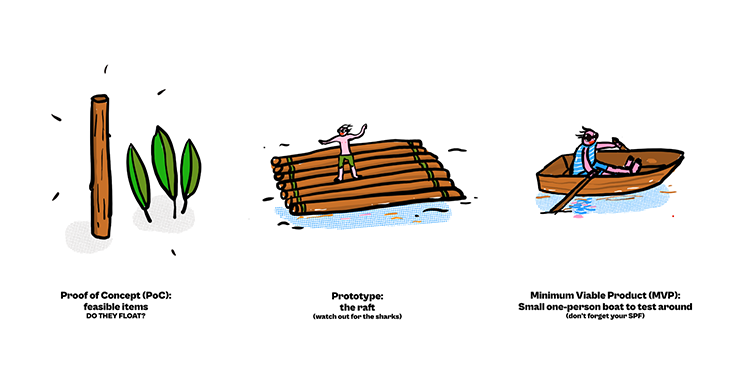Building a product is never easy — there are so many ways to do it that it may become overwhelming even to start outlining your idea. Should you start with a prototype, MVP, or a minimum lovable product? The answer is always in your goals, resources, and stage of maturity, of course.

This article aims to guide you through the challenges of developing a product, and decluttering the path to a proof of concept (PoC) while considering limited resources, conflicting priorities, unclear goals, and unanticipated issues.
A PoC is literally the evidence that your idea is feasible and is based on an experiment or pilot to demonstrate that your idea works — it can be a report document or a literal piece of software. No matter if it’s a design or business proposal, a new stack for an existing product, a feature, or an innovative wearable to be built, the PoC can even be the smallest increment you can think of.
A PoC is meant for when you plan to build a solution and you are not sure of how feasible, expensive, or scalable it is. So, you just build a small component of it to help you understand what it takes to transform this idea into reality — before investing A LOT of money in the real solution.
The PoC is a small part of your project that exists just to see if it works. Once you learn the conditions under which your idea can be implemented, the best next thing to do is to create a prototype.
A prototype is the first design of your actual product. It can be static, like a wireframe, to outline the layout of your entire product and all the flows. Or it can be dynamic, where you design every screen and add some clickable components.
The prototype will help you experience the solution so you can better see how it looks and feels from a visual and/or functional perspective.
The minimum viable product (MVP) is the first version of your product. It’s developed so you can get a first reaction from your users before going big.
In summary, a PoC may help you identify the right technology, the prototype gives you the direction, and the MVP gives you the market reaction before developing a more advanced version.
Ok, explain like I’m five!
Say you want to build a boat for four people stranded on an island. The PoC could be checking what type of boat material will float best near your island (considering the saltiness, currents, and all), the prototype can be an actual raft, and the MVP can be a small, one-person boat for someone to test around:

The end product (the boat) will be a scaled version of the MVP — with some improvements from the person or people who tested the one-person boat, most likely.
Unsurprisingly, there are several reasons why creating a PoC is helpful.
PoCs help you identify the right solution to move forward with. No matter if you build a functional, visual, or experimental PoC, the effort will be low. In return, you will know the necessary resources to build the entire solution, you’ll uncover uncertainties, and it’ll help you focus on your goals.
PoCs will make you consider logistics ahead of time, so you can streamline your work and advance more efficiently to the next step.
PoCs give you a strong start with investors. If an idea is too big for the world to grasp easily and you need the public or your investors’ trust, use a PoC to showcase an overview of the risks and rewards you can foresee. The chances of success will be far higher than going in front of them with a simple pitch deck.
Sometimes, a PoC will demonstrate that your idea is feasible but super expensive. Or extremely difficult to put in place. It can be a matter of scaled manufacturing, rare technology, or any other logistic problem. A PoC will help you prepare for the challenges ahead or pivot your idea (and build another PoC).
On the other hand, PoCs are not meant to be re-used or exposed to customers, and it is definitely not scalable. Once you build a PoC, its goal is achieved.
A successful proof of concept should always have the following elements: clear goals, defined metrics, realistic assumptions, and an appropriate scope.
And before going through the steps of developing (ideation, defining requirements, building a prototype, testing, and validation), you first have to write the proof of concept.
It is crucial to define the problem you want to find the solution for and the audience (end-user, influencer, and decision-makers). This will define if your PoC will be functional, visual, or experimental.
Ensure that everyone’s interests and needs are considered and outline all the contributors needed for the creation process.
Jot down all the available resources you have. This includes your team and capabilities, production materials or partners, budget limitations, and the plan for the PoC.
To evaluate the PoC effectiveness, you need to define the exact use case you want to cover and specific metrics to look at. The metrics will help you figure out if your idea is meeting the idea of the use case. A few examples of metrics to look at are:
People tend to start with a PoC, and soon enough it becomes a prototype or an MVP. Write down your scope to ensure that the outcome will be achievable and, most importantly, relevant to the problem being addressed.
Finally, record a realistic timeline and the context of the PoC, including the start date, process, and next steps based on the outcome. For example, write down if the idea is not feasible if it is feasible but if you lack certain resources, if the idea is feasible and within the success definition, etc.
To make things easy, I created a PoC template, aka a creation canvas, for you to download off of Google Sheets. The template comes with an example as well.
With this template, you can easily organize your PoC goals and information to ensure an impactful outcome.
Proofs of concepts (PoCs) exist to help you know if an idea or solution is feasible in certain conditions. Do not forget that it’s never meant to be used for user-facing interactions, nor to build on top of — PoCs are very unstable, very much like an experiment.
Building the PoC will guide you forward, and you can better plan your time, resources, risk mitigation assessments, and a competitive advantage for the next iterations.
Writing a PoC helps you stay focused on what you want to achieve. It frames the problem, scope and expectation, audience, stakeholders, resources, success definition, and timeline.
Featured image source: IconScout
LogRocket identifies friction points in the user experience so you can make informed decisions about product and design changes that must happen to hit your goals.
With LogRocket, you can understand the scope of the issues affecting your product and prioritize the changes that need to be made. LogRocket simplifies workflows by allowing Engineering, Product, UX, and Design teams to work from the same data as you, eliminating any confusion about what needs to be done.
Get your teams on the same page — try LogRocket today.

A fractional product manager (FPM) is a part-time, contract-based product manager who works with organizations on a flexible basis.

As a product manager, you express customer needs to your development teams so that you can work together to build the best possible solution.

Karen Letendre talks about how she helps her team advance in their careers via mentorship, upskilling programs, and more.

An IPT isn’t just another team; it’s a strategic approach that breaks down unnecessary communication blockades for open communication.